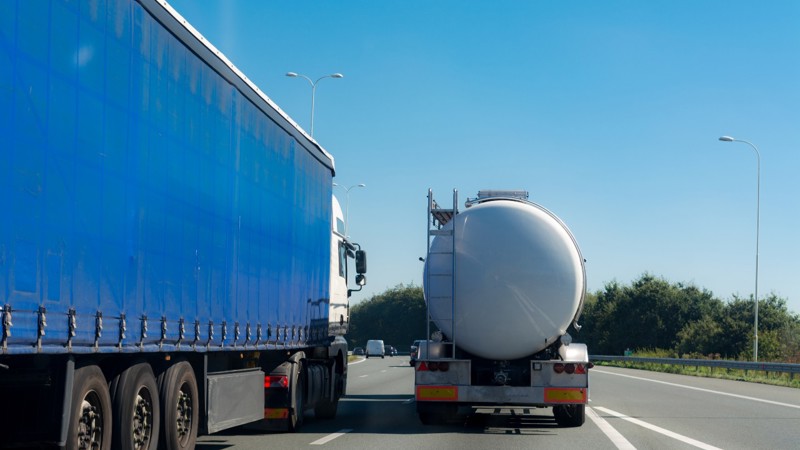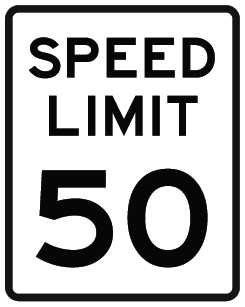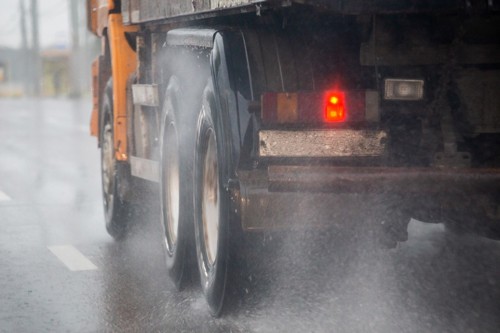Driving around large vehicles and HGVs
HGVs are often considerably longer, heavier, and more powerful than standard vehicles and care needs to be taken when driving close to one.

Due to their size, HGVs have poor visibility and take longer to react and slow down than other vehicles. Collisions between HGVs and other vehicles are more likely to cause serious injury or death.
Three points to remember
There are three simple ways you can improve your safety when driving around HGVs and other large vehicles.
1. Stay visible
Avoid driving in HGVs' blind spots for long periods. Assume that if you’re not able to see the vehicle’s external mirrors, the driver can’t see you. HGVs have larger blind spots than regular vehicles.
2. Pass with care
Make sure you have enough room to complete your overtaking manoeuvre before committing yourself. It takes longer to pass a large vehicle. After passing the HGV, ensure there is plenty of room in front of it before pulling in, otherwise, the driver may not be able to see you and will be unable to stop safely if you have to brake.
3. Give more space
An HGV driver may not be able to see you or be able to stop if you try to pass them while they are turning, so wait until they have completed their turn before passing. Assume that they'll need more than their own lane to turn. They may need to cut a corner when turning at an intersection.
Areas of limited vision
HGVs have zones of limited vision larger than regular vehicles. Avoid driving in these zones for longer than is necessary.
A general rule is that if you're not able to see the truck’s external mirrors, the driver can’t see you. Get out of the zone by either overtaking, if safe, or by pulling back to where you can be seen.
An HGV driver may not be able to see you or be able to stop if you try to pass them while they are turning, so wait until they have completed their turn before passing.
Overtaking large vehicles
-
When you're preparing to overtake an HGV, first drop back from the vehicle in front. This will increase your ability to see ahead and should allow the HGV driver to see you in their mirrors. Getting too close to an HGV will obscure your view of the road ahead.
-
Make sure you have enough room to complete your overtaking manoeuvre before committing yourself. It takes longer to pass a large vehicle. If in doubt, don't overtake.
-
Don't assume you can follow a vehicle that is overtaking a long vehicle. If a problem develops, they may abort overtaking and pull back in.
-
After overtaking, don't cut in too quickly. Otherwise, the HGV might have to brake to keep an adequate, safe distance.
(Highway Code Rule 164: Do not cut in too quickly)
Speed restrictions
Due to its weight, an HGV will take more time to accelerate, especially when starting or going uphill.
Be prepared to adapt your driving when you're around HGVs by reducing speed. HGVs' speed is restricted to 60mph on motorways and dual carriageways, and to 50mph on single carriageways.


Lane restrictions
HGVs are restricted to using lanes 1 and 2, and on a four-lane motorway lane 3. HGVs are not allowed to use the furthest right lane (sometimes known as the outside lane).
Joining a motorway
Use the slip road to accelerate until your speed matches that of the traffic on the motorway. Start to indicate early - remember that HGVs have poor visibility, and don’t try to force your way into a small gap. Be prepared to stop and wait if necessary.
'Abnormal load’ vehicles - wide loads
‘Abnormal load’ vehicles are slower, take up more road space (sometimes more than one lane) and take longer to stop. They may pull over occasionally to allow other traffic to pass.
Allow more space
Large vehicles may need extra road space to turn or to deal with a hazard that you're not able to see. If you're following a large vehicle, such as a bus or an HGV, be aware that the driver may not be able to see you in the mirrors. Be prepared to stop and wait if it needs room or time to turn.
(Highway Code Rule 221: Large vehicles need extra room)
Hazardous conditions
You need to take particular care when driving close to HGVs in bad weather. For example, if the road is wet, water can splash on your windshield as you overtake, reducing your vision to almost zero. Remember that HGVs need extra room to brake and to manoeuvre.
Be extra careful at times when visibility is poor, such as after dark or at dusk.

Left-hand-drive vehicles
Motorways and dual carriageways are often used by HGVs from other countries, which may be left-hand drive. The driver sits on the left-hand side of the vehicle, so will be able to see less of the road and the traffic around them. Their limited vision zones will be reversed.
If you're behind an HGV, it may not be clear that it's a left-hand-drive vehicle, so please take care not to drive too close to all HGVs.
